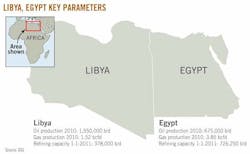Preliminary assessment of Arab Spring's impact on oil and gas in Egypt, Libya
View Article as Single page
Foreign investment
The International Energy Agency estimates that the world will need $10 trillion of investment in the oil sector and $9.5 trillion in the natural gas sector in 2011-35.4 It also projects that most oil and gas supplies will come from the Middle East. In other words, to meet the growing global demand, substantial investments have to be made to develop oil and gas deposits in the Middle East.
Most of these investments are likely to come from international oil companies (IOCs). These IOCs generally prefer to invest in stable regions. True, there are attractive opportunities in Libya, Egypt, and others, but security and stability have to be restored first to attract foreign investments. Furthermore, new deals are likely to be closely scrutinized due to the growing public demand for transparency and accountability.
In addition to these general implications, each Arab country has responded to the Arab Spring in a unique way, based on its history, culture, and the overall socioeconomic and political structure. In the following two sections I closely examine the impact of Arab Spring on oil and gas industry in Egypt and Libya.5 The analysis highlights the similarities and differences between the two North African states.
Egypt
Domestically and internationally three sections in Egypt's energy sector are particularly important: oil and natural gas production, refining, and shipping (Suez Canal, SUMED, Arab Peace Pipeline).
The toppling of the Mubarak regime had little if any impact on production and refining. Similarly the transportation of oil and gas through the Suez Canal and SUMED was not interrupted. The biggest impact was the repeated attacks on and sabotage of the pipeline that carries natural gas to Israel (and Jordan).
Egypt is not a major oil producing country. The nation's oil production peaked in 1996 at 935,000 b/d and has since declined (736,000 b/d or 0.9% of world's total in 2010). Despite new discoveries and enhanced oil recovery techniques at mature fields, crude oil production continues its decline.6 In 2010 consumption reached 757,000 b/d, which means that Egypt has to rely on foreign imported supplies to meet its growing needs.
The decline in oil production has been offset by the rapid development of the natural gas sector for both domestic consumption and export. Over the past decade, Egypt has emerged as a key gas producer and exporter.
Egypt holds the third largest proved gas reserves in Africa after Nigeria and Algeria. From 2000 to 2010 the country's production grew threefold to 62.7 bcm from 21 bcm. This impressive surge in production, however, was restrained by a rapid rise in consumption. During the same decade consumption more than doubled to 45.1 bcm in 2010 from 20.0 bcm in 2000.
The impact on production and consumption is mixed. Oil and gas fields were not attacked during the uprising that toppled Pres. Mubarak. Still, the government has been actively trying to attract foreign investments to increase exploration and production. The volume of foreign investment is likely to reflect and to be driven by the level of political and economic stability in post-Mubarak Egypt.
Furthermore, prior to the uprising, the government planned to reduce and slow the rapid rise in energy consumption by gradually targeting subsidies. Given the public anger over high prices, it is highly unlikely that reforming energy prices will be a major priority to the new leaders in Cairo. Instead, increasing public spending and maintaining public subsidies are likely to prevail.
With 10 refineries, Egypt has the largest refining sector in Africa. Indeed, refining capacity exceeds domestic demand, which prompts Cairo to import crude oil, process it, and export it.
In recent years plans were made to further expand the country's refining capacity. Such plans require substantial foreign investments. Again, securing these investments requires stable economic and political environment and improved internal security.
Displaying 2/7
View Article as Single page

